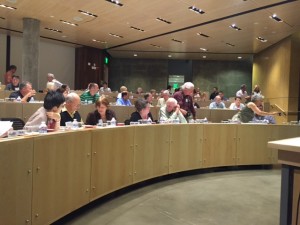“There is life after cheddar.” That was the working title of Prof. Moshe Rosenberg’s talk about the chemistry of cheese at “The Flavors of Chemistry” event September 12th at the Mondavi Center. Rosenberg, Prof. Andrew Waterhouse, and Dr. Selina Wang spoke about the chemistry of cheese, wine, and olive oil, respectively, at the event.
Rosenberg, Professor and Specialist in Dairy Engineering and Technology in the Food Science and Technology Department at UC Davis, talked about the fact that cheese consumption in the U. S. is dominated by two kinds of cheese: cheddar and mozzarella. He, of course, prefers any other, more interesting kind of cheese. He also noted that anyone who can digest cheese past the age of infancy was a genetic mutant since humans historically could not digest lactose past the age of breastfeeding.
Rosenberg talked about a variety of characteristics of cheese, including the physic-chemical properties of cheese curd such as pH and redox potential. He also talked about how the flavor compounds in cheese are related to three main milk components: lactose, citrate, and casein. Proteolysis of these compounds leads to formation of the flavor compounds. In fact, as Rosenberg said, if you are at a cocktail party and the cheese is too bitter, simply mention that “I think it is due to excess proteolysis.”
Waterhouse, Professor of Enology in the Department of Viticulture and Enology at UC Davis, talked about the chemistry of wine. In his introduction, he noted that all cabernet sauvignon grapes originated as a single cross between a cabernet franc grapevine and a sauvignon blanc grapevine about 500 years ago. In theory, all cabernet sauvignon vines are identical though small mutations have occurred over time.
Waterhouse talked about a number of compounds in grapes. In particular, he talked about flavonoids as “sunscreen for grapes” since they are present in the skins of grapes and absorb ultraviolet light. These compounds soften the astringency and mouthfeel of the tannins in wines. In one study, it was found that wines with approximately 50 mg/L of total flavonoids were in most widely sold, relatively inexpensive wines while concentrations of 200 mg/L were found in primarily high priced wines.
Wang, Research Director of the UC Davis Olive Center, spoke about her work on the chemistry of olive oil. One of the most widely known projects she worked on was a report about how most “extra virgin” olive oil on the market did not, in fact, meet the quality standards required to get the “extra virgin” label: to get the label, the olive oil must not have any imperfections, such as rancidity. Wang talked about what it meant, chemically, to meet the standards. She also talked about how olive oils from different regions have different fatty acid profiles.
During the tasting of the olive oils, it quickly became clear which olive oil was worthy of the extra virgin label and which one was not. Wang also gave a list of things to look for when purchasing olive oil: insist on a harvest date on the bottle, look for a quality seal (e.g., California Olive Oil Council), and keep it in a cool, dark place. When buying a bottle of olive oil, make sure that you plan on using it over a couple of months.
ACS Sacramento Section honored its members who have been 50 and 60 year members of ACS. Joe Digiorgio, Marilyn Olmstead, and Jerry Wilson were honored.
The event was sponsored and attended by members of the Santa Clara Valley, California, and Sacramento sections, the first (but hopefully not the last) event coordinated by these three sections in the past several years. Within the Mondavi Center, the lectures and tastings occurred in the Sensory Theater.


